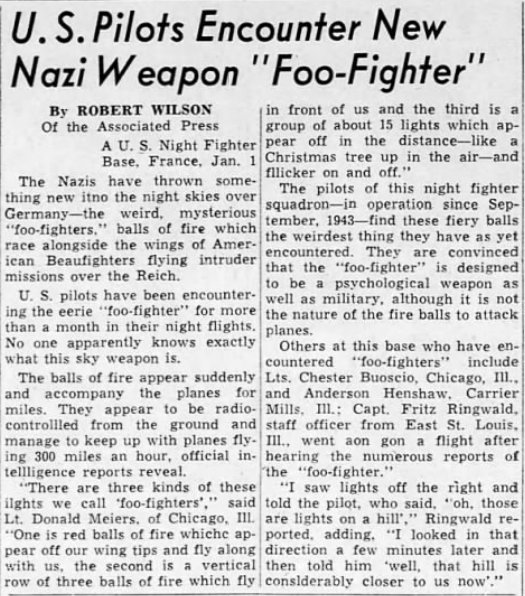The article below was published in the daily newspaper The Decatur Herald, Decatur, Illinois, USA, page 8, on January 2, 1945.

|
By ROBERT WILSON
Of the Associated Press
A U.S. Night Fighter Base. France. Jan. 1
The Nazis have thrown somethig new into the night skies over Germany - the weird, mysterious "foo-fighters," balls of fire which race alongside the wings of American Beaufighters flying intruder missions over the Reich.
U.S. pilots have been encountering the eerie "foo-fighters" for more than a month in their night flights. No one apparently knows exactly what this sky weapon is.
The balls of fire appear suddenly and accompany the planes for miles. They appear to be radio-controlled from the ground and manage to keep up with planes flying 300 miles an hour, official intelligence reports reveal.
"There are three kinds of these lights we call 'foo-fighters'", said Lt. Donald Meiers, of Chicago, Ill. "On is red balls of fire which appear off our wing tips and fly along with us, the second is a vertical row of three balls of fire which fly in front of us and the third is a group of about 15 lights which appear off in the distance - like a Christmas tree up in the air - and flicker on and off."
The pilots of this night fighter squadron - in operation since Spetember, 1943 - find these fiery balls the weirdest thing they haveas yet encountered. They are convinced that the "foo-fighters" is designed to be a psychological weapon as well as military, although it is not the nature of the fire balls to attack planes.
Others at this base who have encountered "foo-fighters" include Lts. Chester Buoscio, Chicago, Ill., and Anderson Henshaw, Carrier Mills, Ill; Capt. Fritz Ringwald, staff officer from East St. Louis, Ill., went aon gon [sic, along on] a flight after hearing the the numerous reports of the "foo-fighters."
"I saw lights off the right and told the pilot, who said, 'oh, those are lights on a hill'," Ringwald reported, adding, "I looked in that direction a few minutes later and then told him 'well that hill is considerably closer to us now'."